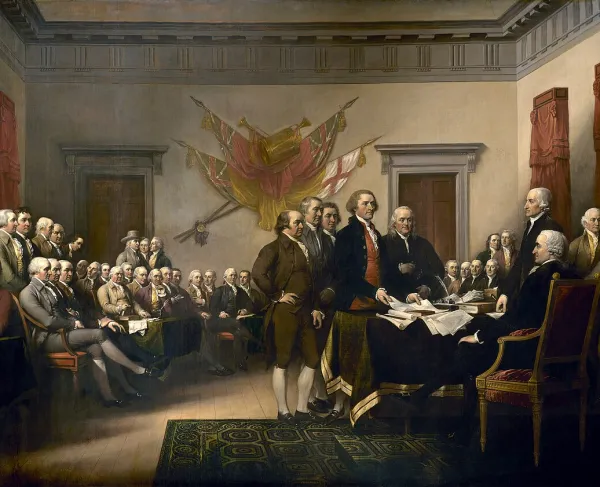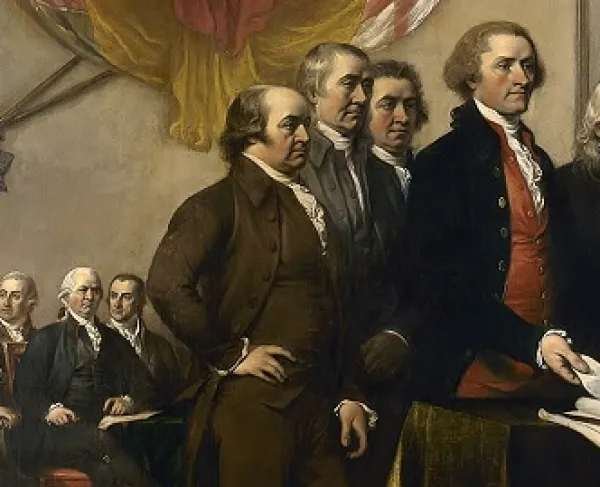
Declaration of Independence (1819), by John Trumbull
The Declaration of Independence is one of the founding and most fundamental documents of the United States. On July 4, 1776, during the American Revolution, the Second Continental Congress adopted the famed document drafted by Thomas Jefferson that pronounced the independence of the thirteen states, previously the Thirteen Colonies. The Declaration was adopted at a point in time when Congress had determined that their grievances against Great Britain were irreconcilable and the majority in Congress agreed that independence was the best solution. The Declaration of Independence was a reaction to years of injustices waged by Great Britain that served to unify the Thirteen Colonies together under mutual frustrations. With Congress’ adoption of the Declaration, unity was felt throughout the colonies, and the Thirteen Colonies took an important step toward becoming the United States of America.
By the time the Declaration was adopted by Congress, the American Revolution had already been going on for over a year. Even after the war broke out, there was no immediate movement toward independence; the war was more so a reaction to years of negative relations between the Thirteen Colonies and Great Britain. A decade before the war began, colonists were already at odds with the British Parliament in reaction to unfair taxation and oppressive regulations on the colonies. British measures such as the Stamp Act and the Townshend Act imposed strict taxes on the colonists as a way for Great Britain to make up for the money lost from the Seven Years’ War (French and Indian War in North America). One of the colonists’ main grievances waged against Parliament and these taxes was that there was no representation in Parliament on behalf of the colonies. As time went on, more colonists began to question the legality of Parliament’s jurisdiction over the colonies at all, with some arguing that Parliament had no jurisdiction in the colonies because the colonies had their own legislatures.
Prior to the outbreak of the American Revolution, an important ruling body within the Thirteen Colonies was the Continental Congress, which had been formed as a reactionary measure to Great Britain’s unjust measures. The Continental Congress consisted of a meeting of delegates from each colony to discuss actions that should be taken in response to Great Britain before, and later, during the war. At the Second Continental Congress in May 1775, while some delegates believed that independence was the best course of action, most delegates were not yet adamantly calling for independence.
The movement towards independence was jumpstarted by soldier and author, Thomas Paine, who published his pamphlet, “Common Sense” in January 1776, a powerful message that advocated for independence from Great Britain. “Common Sense” was widely published and accepted among colonists, igniting, or further fueling colonists’ desire for independence. While some colonists still held out hope for reconciliation with Great Britain, punitive actions of King George and Parliament towards the colonies convinced many colonists that there could be no peace with the mother country.
In 1776, colonies began authorizing their delegates to vote for independence in documents such as the Halifax Resolves in North Carolina. Other colonies including Rhode Island and South Carolina denounced their allegiance to Great Britain and declared that the British Parliament and King no longer had jurisdiction in their colony. While some delegates, such as John Adams, spoke adamantly about the need for independence, other colonies held back, not yet willing to join the movement. On May 15, 1776, John Adams wrote a preamble calling for all colonies to suppress the rule of Great Britain and establish new governments within their individual colonies. Despite multiple colonies disagreeing with Adams’ preamble and voting against it, Congress passed the preamble. On June 7 of that same year, Richard Henry Lee of Virginia presented a resolution, “The Lee Resolution,” calling on Congress to declare independence. Congress postponed the adoption of Lee’s Resolution for a few weeks and established the “Committee of Five” to draft a document announcing independence if Lee’s Resolution should pass. The Committee of Five consisted of John Adams, Thomas Jefferson, Benjamin Franklin, Robert R. Livingston, and Roger Sherman. The men in the Committee consulted about the outline of the declaration and determined that Thomas Jefferson should write the first draft.
On June 11, 1776, Jefferson began to write his version of the Declaration of Independence, drawing on previous documents of significance, such as the Virginia Declaration of Rights and ideas from the enlightenment and John Locke to express his sentiments. On June 28, after making some changes as a group, the Committee of Five presented Jefferson’s version of the declaration to Congress. Congress took the draft and made some significant changes to it, rearranging sentence structures, shortening the length, and significantly, removing a clause the blamed King George III for the slave trade in the colonies. The powerful ideas echoing throughout the Declaration were intended for a wide audience. The Declaration was not only meant to reach Americans and the King, but the general world as well. The document was meant to reach foreign allies and announce to the world that the colonies were now a new country.
The Declaration was structurally divided into three sections. The preamble outlined the rights of man and the right for the colonists to fight for their cause. The words of the preamble were meant to unite Americans under a realization that the future could be brighter if they continued to fight. The second section of the Declaration outlined the grievances against King George III to remind everyone of the tyranny that the King exercised over the colonists and thereby justify their fighting. The third section was the actual declaration of the independence of the thirteen colonies as free and independent states.
After some deliberation over a few days, Congress eventually voted to adopt the resolution of independence, and 56 men signed the Declaration. On July 4, 1776, the Declaration of Independence was approved for printing and publication. The founding document continues to be a pillar of American rights and principles and a foundation of freedom.





